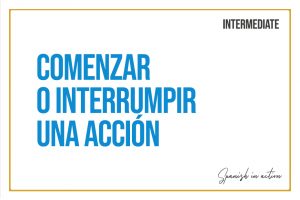Lee este artículo en español
There are different learning styles. Some of us are more analytical and structured, others are more abstract and associative. Some of us are visual and others more auditory. Others need to feel. The truth is that whatever is our style, in the case of learning a language, there are mandatory strategies and also inexcusable content. Repetition, for example, is a very necessary strategy to mentalize vocabulary and structures. Grammar is an essential content for Spanish teachers.
Questions regarding grammar arise: what is the role of grammar in learning a second language and specifically Spanish? What is the exact amount of grammatical content that is required to learn? Why are there people who have learned Spanish without studying grammar?
There are questions, there are concerns and there are very common expressions: I never liked grammar at school and it never went well for me. I don’t even know what a verb is in my own language. I am an engineer or doctor, not a linguist. Does any resonate with you?
We are going to systematize these questions, concerns and frequent expressions about the role of grammar in Spanish teaching . I will summarize it in three answers that I give to your corresponding questions once some of you have become aware of our way of teaching at www.spanishperfecto.com
Question 1: Do students need to understand all those categories like verbs, adjectives, prepositions, indicatives, subjunctives, imperfects, pluperfect…?
Answer 1. Yes, students enrolled in good Spanish schools not only understand grammatical categories, but end up having more grammatical awareness and passion for it than native speakers. Believe it, you end up having moments of pleasant discovery when you manage to deduce some pattern from an explanation to another linguistic situation that comes your way in the future.
And language awareness is natural in adulthood. The marketing tells us, at this stage of life, a language is learned as a child is not true. It is true that there is a similar learning cycle: acquisition, development and use, but the process is artificial both in a teaching center and in the same immersive context when it comes to an adult. It is promoted and aware. And by becoming aware of patterns there is also a trend of analysis.
Question 2: Do students need to know grammar to be fluent in a second language?
Answer 2: No, but let’s start by not calling them students but speakers of Spanish as a second language. Many of them learn with repetition tools, like listening to songs; also by contact with the culture, if they have aSpanish- speaker babysitter; or they like Mexican food and go to restaurants; or they have a Hispanic girlfriend and they listen to her talking to her family; by direct immersion.
In this case, you will always have to see your motivation and your own acquisition skills. I am referring to your hearing ability, for example.
These types of learners also have learning awareness but are more associative than analytical.
Question 3: Does a teacher need to know grammar or is it enough to be a native speaker and a good teacher?
Answer 3: Yes and no. How so? I give you three reasons:
-The student’s learning style, as I told you above. Some hear, repeat and use. Others ask about a grammar structure, analyze, and only then use. A teacher will have to identify the learning style of his student and put at his service the most effective tool. And what if the student is one of those who demands information? The teacher cannot limit himself to saying that it is not necessary to know to learn, he must give everything the student demands to develop and speed up his process.
-There are levels that require more grammatical information than others. A1 beginner level emphasis on basic vocabulary and grammar. However, in the intermediate level, for verbs contrasts and pronouns, the grammatical distinction is profoundly useful. If a teacher does not know how to distinguish between an impersonal se, or a reciprocal or reflexive one, or an accidental one, or one that simply changes the meaning, or the indirect object one, how will the student know when to change it ?
In this case it will also depend on the correction level which the apprentice aspires to.
-A teacher with these three components, a native speaker, a good teacher, and with grammatical training, will know how to introduce grammar even in the most modern approaches. Subordinating it to the objectives and communicative functions. Making strategic use of it without putting it in the center of the class. A good Spanish teacher makes grammar a challenge to knowledge. A good Spanish teacher does not impose grammar as a way of learning, he offers grammar as a seduction mechanism before the student’s progress.
Do you have such a teacher? Native, good teacher and with grammatical training?
We do have those in our school.



